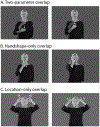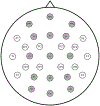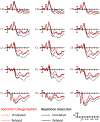The organization of the American Sign Language lexicon: Comparing one- and two-parameter ERP phonological priming effects across tasks
- PMID: 33940343
- PMCID: PMC8543839
- DOI: 10.1016/j.bandl.2021.104960
The organization of the American Sign Language lexicon: Comparing one- and two-parameter ERP phonological priming effects across tasks
Abstract
We used phonological priming and ERPs to investigate the organization of the lexicon in American Sign Language. Across go/no-go repetition detection and semantic categorization tasks, targets in related pairs that shared handshape and location elicited smaller N400s than targets in unrelated pairs, indicative of facilitated processing. Handshape-related targets also elicited smaller N400s than unrelated targets, but only in the repetition task. The location priming effect reversed direction across tasks, with slightlylargeramplitude N400s for targets in related versus unrelated pairs in the semantic task, indicative of interference. These patterns imply that handshape and location play different roles during sign recognition and that there is a hierarchical organization for the sign lexicon. Similar to interactive-activation models of word recognition, we argue for differentiation between sublexical facilitation and lexical competition. Lexical competition is primarily driven by the location parameter and is more engaged when identification of single lexico-semantic entries is required.
Keywords: ERPs; Phonological priming; Sign language; Task demands.
Copyright © 2021 The Author(s). Published by Elsevier Inc. All rights reserved.
Conflict of interest statement
Declaration of Competing Interest
The authors declare that they have no known competing financial interests or personal relationships that could have appeared to influence the work reported in this paper.
Figures






Similar articles
-
Are form priming effects phonological or perceptual? Electrophysiological evidence from American Sign Language.Cognition. 2022 Mar;220:104979. doi: 10.1016/j.cognition.2021.104979. Epub 2021 Dec 11. Cognition. 2022. PMID: 34906848 Free PMC article.
-
Tracking the time course of sign recognition using ERP repetition priming.Psychophysiology. 2022 Mar;59(3):e13975. doi: 10.1111/psyp.13975. Epub 2021 Nov 17. Psychophysiology. 2022. PMID: 34791683 Free PMC article.
-
Electrophysiological evidence for phonological priming in Spanish Sign Language lexical access.Neuropsychologia. 2012 Jun;50(7):1335-46. doi: 10.1016/j.neuropsychologia.2012.02.018. Epub 2012 Mar 1. Neuropsychologia. 2012. PMID: 22401990
-
Electrophysiological studies of visual word perception, lexical organization, and semantic processing: a tutorial review.Lang Speech. 1989 Jul-Sep;32 ( Pt 3):205-20. doi: 10.1177/002383098903200302. Lang Speech. 1989. PMID: 2701178 Review.
-
Cross-language phonological activation in bilingual visual word recognition: A meta-analysis.Psychon Bull Rev. 2025 Apr 11. doi: 10.3758/s13423-025-02692-8. Online ahead of print. Psychon Bull Rev. 2025. PMID: 40216667 Review.
Cited by
-
Tracking effects of age of sign language acquisition and phonology in American Sign Language sentence processing.Mem Cognit. 2025 Mar 27. doi: 10.3758/s13421-025-01695-z. Online ahead of print. Mem Cognit. 2025. PMID: 40146408
-
New Perspectives on the Neurobiology of Sign Languages.Front Commun (Lausanne). 2021 Dec;6:748430. doi: 10.3389/fcomm.2021.748430. Epub 2021 Dec 13. Front Commun (Lausanne). 2021. PMID: 36381199 Free PMC article.
-
Are form priming effects phonological or perceptual? Electrophysiological evidence from American Sign Language.Cognition. 2022 Mar;220:104979. doi: 10.1016/j.cognition.2021.104979. Epub 2021 Dec 11. Cognition. 2022. PMID: 34906848 Free PMC article.
-
Lexical selection in bimodal bilinguals: ERP evidence from picture-word interference.Lang Cogn Neurosci. 2021;36(7):840-853. doi: 10.1080/23273798.2020.1821905. Epub 2020 Sep 21. Lang Cogn Neurosci. 2021. PMID: 34485589 Free PMC article.
-
Sign and Spoken Language Processing Differences in the Brain: A Brief Review of Recent Research.Ann Neurosci. 2022 Jan;29(1):62-70. doi: 10.1177/09727531211070538. Epub 2022 Feb 15. Ann Neurosci. 2022. PMID: 35875424 Free PMC article. Review.
References
-
- Brentari D (1998). A prosodic model of sign language phonology. Cambridge, MA: The MIT Press.
-
- Brentari D (2019). Sign language phonology. Cambridge, United Kingdom: Cambridge University Press.
-
- Carreiras M, Gutiérrez-Sigut E, Baquero S, & Corina D (2008). Lexical processing in Spanish Sign Language (LSE). Journal of Memory and Language, 58(1), 100–122. 10.1016/j.jml.2007.05.004. - DOI
Publication types
MeSH terms
Grants and funding
LinkOut - more resources
Full Text Sources
Other Literature Sources

